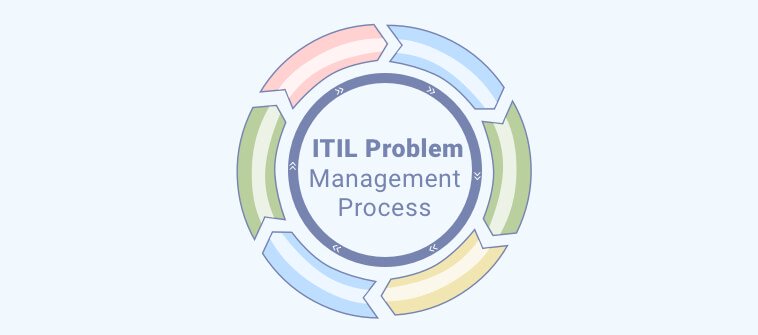IT support teams are always dealing with end-user complaints, inquiries, and service requests. But can you really delight end-users if you don’t know how to differentiate between them?
When you run a business, service requests can come in from all directions. While an employee requests for a new laptop to be issued to them, hundreds of customers share password-reset requests.
Service request management has helped IT teams across the world to enhance the service experience and streamline internal operations. But a clear understanding of what service requests are, how they can be tracked in IT help desk software and fulfilled, are all vital things you should know.
This service request management guide contains important sections that will answer all your questions.
- What Is a Service Request?
- What Is Service Request Management?
- What Is Request Fulfillment?
- Incident Management vs. Service Request Management
- Service Request Management Process
- 8 Service Request Management Best Practices
What Is a Service Request?
A service request can be termed as any formal user request asking the service provider to offer something. This could be a simple request for information, advice, or approval. Users raise service requests when they wish to procure something new they don’t have in the first place.
Some examples of service requests are:
- A manager requests the IT support team to train their team members to use the office projector.
- A graphic designer requests the IT team to install a new graphics card on his office laptop.
Read More: How to Track Customer Requests: Tips & Best Practices
What Is Service Request Management?
Service request management refers to the process adopted by IT support teams to fulfill end-user requests in a timely manner. It involves various stages of the request fulfillment lifecycle, such as registering a request, assigning ownership to an agent, prioritizing based on urgency, and tracking its progress until the request is fulfilled.
An effective service request management process allows end-users to submit requests via a variety of channels. For instance, they can share requests via email, live chat, forms, or raise requests on your website, help center, or any other portal.
To streamline service request management, you can create a service catalog that lists all your current services. The users can then select any of these services and make a formal request. Post that, a service request ticket is generated and assigned to an appropriate IT agent.
What Is Request Fulfillment?
Request fulfillment refers to the process of resolving user requests before they interrupt business processes. The aim of every service team should be to give relevant priority to each request and resolve them at the earliest.
For this, most businesses have response SLAs (service level agreements) to ensure agents handle requests within a specific timeframe. For example, requests sent via email should be responded to within 4-24 hours. Similarly, agents should reply to chat request inquiries within 2 minutes.
Incident Management vs. Service Request Management
While trying to decode what service requests mean, you must have stumbled upon other ITIL practices, such as incident management. Now, some businesses use the terms “incident management” and “service request management” interchangeably, leading to confusion and poor service experiences.
Here are some common differences between incident management vs. service request management:
1. Definition: The major difference between incident and service request can be understood by their definitions.
- Service Request: A service request is a formal request made by a user for something to be provided to them. For example, request for access to the company knowledge base.
- Incident: An incident can be defined as an unplanned event that leads to permanent or temporary service interruption. For example, the company server is down.
2. Urgency: Service requests are usually low-priority compared to incidents. While your service team can take more time to resolve requests, major incidents must be handled on priority to reduce their impact on the business. For example, the request for access to a software application isn’t as urgent as an incident that caused your eCommerce website to malfunction.
3. Examples: The difference between these two ITIL processes can also be highlighted with the help of examples. This image will make it crystal clear.
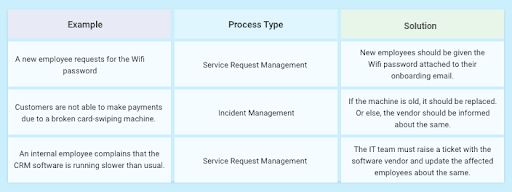
When your service team is bombarded with hundreds of customer or employee issues, it’s important to clearly organize them into requests and incidents. Creating distinctive workflows will help your team save time, avoid confusion, and improve the service experience.
Read More: Incident vs. Service Request: Understanding the Difference With the Help of Examples
FREE. All Features. FOREVER!
Try our Forever FREE account with all premium features!
The Service Request Management Process
The service request lifecycle begins when a user raises a request and ends when it is marked as resolved. In this section, we will learn the service request management process with the help of a simple example.
- In the first step, a user submits a request via available communication channels such as web forms, phone, email, live chat, help center, etc. For example, let’s say a new employee requests access to the company’s internal knowledge base.
- Now, once the request is received in the help desk software, it is converted into a ticket and can be automatically assigned to an available service agent. Let’s say the above request is assigned to Jim based on his skills and availability.
- The service agent can take necessary actions on the request to ensure it is fulfilled in time. For example, Jim performs the following actions on the request ticket:
- He marks the request as high priority
- Adds a suitable Label “KB Access” for better organization
- Tags the service manager to seek approval
- Once these actions are performed, the agent can respond to the user with a prompt solution. In this case, Jim gets the required approval, creates a new user account, and shares the login credentials with the new employee. Later, Jim marks the ticket as closed and sends an automated CSAT survey to capture user feedback.
8 Service Request Management Best Practices
Simply fulfilling each and every service request that comes to you isn’t good enough. You must look for proactive ways to reduce end-users’ efforts and enhance agent productivity.
Here are some top service request management best practices that you can adopt this year:
1. Automate Time-Consuming Processes With Help Desk Software
Managing service requests can prove to be a time-consuming affair. If your agents are manually handling requests, things can go haywire soon.
By automating your request management process, you can speed up request fulfillment, reduce human errors, reduce costs, and enhance customer satisfaction.
Here are some ways a help desk system can help you automate your process:
- Automated Ticket Assignments: Once service requests are converted into help desk tickets, they can be automatically assigned to relevant agents. This ensures greater accountability, and no time gets wasted due to manual ticket distribution.
- Automated Notifications: Notifications and alerts are sent to people when certain conditions are met. Your agents and end-users can receive automated notifications to stay updated on the ticket’s progress.
- Chatbots: You can develop powerful chatbots with the help of pre-designed templates. These bots can hold human-like conversations 24×7 and automate your request submission process.
Read More: 10 Service Desk Automation Ideas that Boost Performance and Quality
2. Manage Requests Using a Shared Inbox
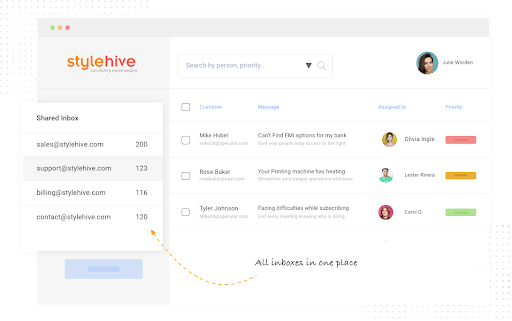
When you have a small team and a handful of users to take care of, email can be a good channel for managing requests. However, email isn’t a long-term solution.
You need a shared inbox tool to centralize service requests from group email accounts such as support@, info@, ITsupport@, admin@, etc. The best part is that multiple agents can access multiple inboxes simultaneously without stepping on each other’s toes.
Whether you receive an employee request at ITsupport@company or a customer request at info@company, you can easily track all service requests in a centralized platform.
Moreover, there are multiple internal collaboration tools that will allow your team to function together in full swing. For example, IT agents can discuss complex requests internally using private notes. They can even view who is working on what and assign request tickets to different departments.
Read More: 10 Shared Inbox Best Practices For Email Success
3. Organize Request Tickets By Their Priorities
If your team receives hundred service requests every day, how do you figure out which ones to fulfill first?
Service request prioritization can help agents organize requests based on their respective priorities. This way, all high-priority requests can stay within arm’s reach.
Undoubtedly, some requests are urgent compared to others and demand an immediate response. For example, receiving a request from the manager to shift the office projector in the conference room for an important meeting. This high-priority service request must be dealt with as soon as possible.
On the other hand, requests for office stationary items or additional hardware are low-priority requests that can be fulfilled in a few days rather than immediately.
4. Reduce Request Ticket Volume With Self-Service
The more your end-users can help themselves, the less work your agents have to do.
According to a study by Harvard Business Review, 81% of customers like to take matters into their own hands before contacting a service representative.
You will be surprised to see that self-service can take many different forms. Here are some top ways to encourage self-service among your customers and employees:
- Knowledge Base: An online knowledge base can contain all self-help material related to request submission, tracking, services on offer, and more. For example, you can create a FAQ page to guide employees or customers on resetting their account passwords. This will help reduce password-reset requests so agents can pay adequate attention to other urgent tasks.
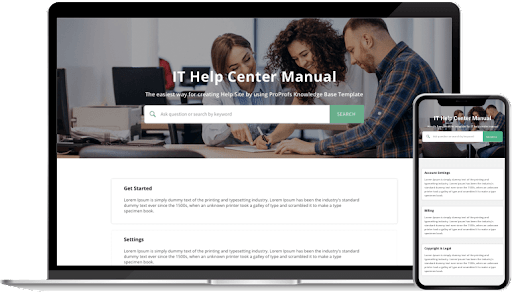
- Online Forums/Channels/Discussion Boards: Online forums or groups are great ways to allow end-users to interact with each other. They can discuss ideas, raise questions, and get solutions to their problems – all in one place. For example, you can create a Slack channel where employees can help each other with their requests or issues.
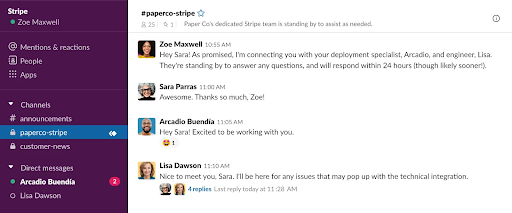
- Customer Portal: A customer portal allows users to track their requests once it is out of their hands. They can simply log in to the portal to check the progress of existing requests or submit new ones.
5. Audit Your Knowledge Base Content From Time to Time
To grow your business, you are constantly improving your products or services, right? But every time you introduce a new feature or modify a service, your knowledge base demands some work.
Imagine you created an article titled “Projector Do’s & Don’ts” around 5 years back. Now, just recently, you received an employee request for projector training. You can’t simply share the same article with the employee, as the technology and hardware must have changed over the years. That’s precisely why content auditing makes sense.
Content creation is not a one-time process. You need to constantly audit your published help articles to keep your knowledge base healthy and breathing.
Here are some points to keep in mind during your content auditing process:
- Define technical terms and jargon: Users should not be left with more questions after reading your content. It’s important to define technical terms or point the users to a relevant resource, such as a glossary of terms.
- Too many authors can be a bad thing: You must have heard the old adage, “two heads are better than one.” However, when it comes to creating help articles, more authors can mean more discrepancies in solutions, language, and tone. Ensure only those with relevant experience can author, edit, and publish articles.
- Use bullets and numbered lists: While writing help articles, you will notice that most of them contain a list of items or steps. It’s important to use bullets and numbered lists to make it easier for the users to scan your articles.
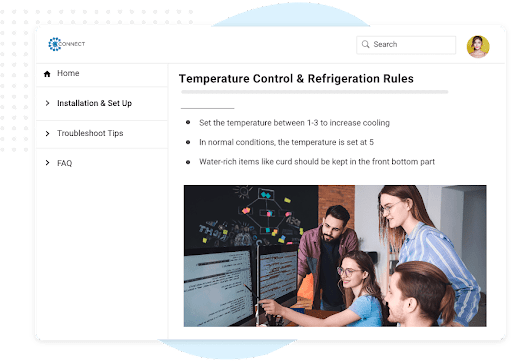
6. Revamp Your Service Catalog
Let’s say you offer a dozen services to end-users. How would users know what those services are and how they can get them? A well-designed service catalog holds the key.
Service catalogs provide a window into the various services offered by your business to customers or internal employees. But creating the right service catalog can be overwhelming.
Here are points to keep in mind while creating or updating your catalog:
- Define items: Your service catalog should not be just a boring list. It should clearly define the services on offer, their respective turnaround times, and costs (if you charge your end-users). Adding visual graphics to your catalog will also enhance the browsing experience.
- Integrate your service catalog with your knowledge base: To turn your KB into a one-stop solution, it is important to upload your service catalog to it. If users are not able to find correct information, they can simply browse through your catalog and submit requests.
- Take feedback from users: To improve your service catalog, it is important to take feedback from the people who use it. Ask your users if they are able to easily navigate through your catalog, what challenges they might be facing or what new additions they would like to see.
7. Speed Up Your Service Request Approval Process
We all know that service request approvals can take days or weeks, depending upon the nature of the request. However, an unnecessarily long approval process can hamper the service experience.
The service request approver is a high-authority individual (usually the manager or supervisor) who can approve or reject any service request.
Let us understand how service approvals work. Imagine an employee submitting a request for a new laptop to be given to them. The IT support guy would not have the authority to approve this request. As a result, he shares the approval request with the manager. The new laptop can only be issued to the staff member once the request has been approved.
This can be time-consuming as the manager may already have many such approvals to take care of. As an alternative, you can try to automate this process to some extent. For example, new laptops can be automatically approved for all new joiners. This will speed up the service request handling process and enhance work efficiency.
8. Improve Service Quality With Reports and Metrics
To improve your service quality, you need to keep a tab on reports and metrics relevant to your process. But be cautious about overdoing things.
Most managers can get lost in a sea of data while trying to improve service quality. But more information doesn’t necessarily mean better insights.
Here are some metrics you can track for continuous service improvements:
- Open tickets
- Average first response time
- Average resolution time
- Customer satisfaction (CSAT)
The number of open or pending tickets highlights how many service requests need to be handled by your team. Monitoring this metric over time will help you assign work appropriately and understand your staffing requirements. The average first response time is another crucial metric to understand how much time your team takes to share the first response with a user. A quick first response rate can help you establish trust with customers and employees.
Customer-oriented metrics such as CSAT, NPS, and CES can help you monitor how happy people are with your efforts. You can even look to include open-ended questions in your surveys, such as – “What can we do to improve our service request fulfillment process?” The user responses will act as a mirror to your process and give you a clear picture of your improvement areas
Read More: 15 Help Desk Metrics to Improve Customer Support
Deliver Delightful Experiences With Service Request Management
Getting service request management right is not rocket science. By gearing up your IT support team with the right tools and knowledge, you can ensure smooth internal operations and boost customer satisfaction.
You can create a dedicated knowledge base to allow your agents to focus on important tasks. This will encourage self-service and help you reduce support costs. Moreover, you must also look to revamp your service catalog and speed up your request approval process for a better experience.
We hope through this guide, we were able to answer all your questions. If you are looking to automate your service request handling process, look no further. ProProfs Help Desk is a cloud-based tool that can help your team track and resolve service requests via email, live chat, web forms, help center, and multiple other channels.
 Tips
Tips
We’d love to hear your tips & suggestions on this article!
FREE. All Features. FOREVER!
Try our Forever FREE account with all premium features!

 We'd love your feedback!
We'd love your feedback! Thanks for your feedback!
Thanks for your feedback!


